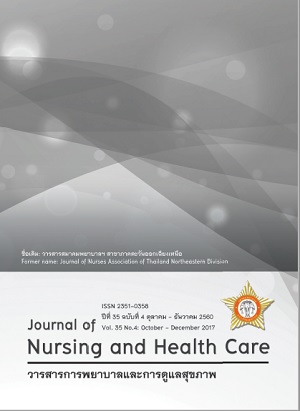การทำงานของเครือข่ายชุมชนเพื่อเพิ่มการเข้าถึงบริการสุขภาพช่องทางด่วนของผู้ป่วยกล้ามเนื้อหัวใจขาดเลือดเฉียบพลันชนิดเอสทียกสูง ตำบลโพนทอง อำเภอเรณูนคร จังหวัดนครพนม The Community Networking on Increasing Successful Fast Track for People with ST- elevation M
คำสำคัญ:
โรคกล้ามเนื้อหัวใจขาดเลือดเฉียบพลันชนิดเอสทียกสูง เครือข่ายชุมชน กระบวนการวิเคราะห์ชุมชนแบบมีส่วนร่วม, ST-elevated Myocardial Infarction STEMI, community network, Participatory Rural Appraisal, PRAบทคัดย่อ
รายงานวิจัยนี้ใช้การวิเคราะห์ชุมชนแบบมีส่วนร่วม เพื่อประเมินสถานการณ์การทำงานของเครือข่ายชุมชนในการจัดการเพื่อเพิ่มการเข้าถึงบริการสุขภาพช่องทางด่วนของผู้ป่วยกล้ามเนื้อหัวใจขาดเลือดเฉียบพลันชนิดเอสทียกสูง กลุ่มผู้ร่วมวิจัยประกอบด้วย 5 กลุ่ม คือ 1) ผู้ป่วยโรคกล้ามเนื้อหัวใจขาดเลือดเฉียบพลันชนิดเอสทียกสูง 5 คน 2) ผู้ป่วยกลุ่มเสี่ยงได้แก่ผู้ป่วยโรคเบาหวาน โรคความดันโลหิตสูง และครอบครัว 40 คน 3) องค์กรชุมชน ได้แก่ ผู้ใหญ่บ้าน และอาสาสมัครสาธารณสุขประจำหมู่บ้าน 20 คน 4) เจ้าหน้าที่องค์การบริหารส่วนตำบล และอาสาสมัครกู้ชีพ 3 คน 5) เจ้าหน้าที่โรงพยาบาลเรณูนคร 7 คน ศึกษาระหว่างเดือน ตุลาคม พ.ศ. 2559-มกราคม พ.ศ. 2560 เครื่องมือที่ใช้ประกอบด้วย 1) แนวทางการสัมภาษณ์เชิงลึก 2) แนวทางการเสวนากลุ่ม และ 3) แนวทางการประชุมระดมสมองและสะท้อนคิดเพื่อให้ได้ข้อมูลข้อเท็จจริง และข้อคิดเห็นมากที่สุด ผลการวิจัย มีดังนี้ 1) ข้อมูลทั่วไปของผู้ป่วย ส่วนใหญ่เป็นเพศชายวัยสูงอายุ มีโรคความดันโลหิตสูง ร้อยละ 66.6 2) การรับรู้ของเครือข่ายชุมชน พบมีผู้ป่วย ญาติ อสม.และผู้นำชุมชนไม่ทราบว่าโรคเบาหวานและความดันโลหิตสูงเป็นปัจจัยสำคัญที่ทำให้เกิดโรคกล้ามเนื้อหัวใจขาดเลือดเฉียบพลัน และรับรู้อาการของโรคหัวใจผิดว่าเป็นอาการของโรคกระเพาะอาหาร อาการปวดกล้ามเนื้อ อาการวัณโรคปอด และเป็นการกระทำของผี 3) การเจ็บป่วยก่อนมาโรงพยาบาล พบว่า ผู้ป่วยมีอาการเจ็บหน้าอกเป็นอาการเจ็บเตือนนำมาก่อนถึงร้อยละ 88.8 ซึ่งทั้งหมดไม่เคยได้รับการตรวจรักษาอาการเจ็บหน้าอกมาก่อน ดังนั้นผู้ป่วย ครอบครัวและชุมชนจึงให้การดูแลตามประสบการณ์การรับรู้และรอดูอาการ โดยไม่มีการแจ้งเหตุขอความช่วยเหลือจากระบบปฏิบัติการแพทย์ฉุกเฉิน 4) การนำส่งผู้ป่วยของเครือข่ายชุมชน พบมีผู้ป่วยทั้งหมด 9 คน ถูกนำส่งโดยญาติ อสม. และผู้นำชุมชนเท่านั้น โดยไม่มีการสั่งการจากศูนย์ประสานการรับแจ้งเหตุให้หน่วยกู้ชีพของ อบต. หรือหน่วยปฏิบัติการแพทย์ฉุกเฉินของโรงพยาบาล ออกปฏิบัติการรับผู้ป่วยจากชุมชนมาโรงพยาบาล จึงมีข้อเสนอแนะว่า ที่คลินิกโรคเรื้อรัง ควรให้ความรู้เรื่องโรคและการประเมินอาการของโรคกล้ามเนื้อหัวใจขาดเลือดเฉียบพลันชนิดเอสทียกสูงซึ่งเป็นภาวะแทรกซ้อนที่อันตรายถึงชีวิต และมีความเสี่ยงที่จะเกิดในผู้ป่วยโรคบาหวานและความดันโลหิตสูง และแนะนำการใช้บริการการแพทย์ฉุกเฉินเพื่อนำส่งผู้ป่วยไปยังโรงพยาบาลทันเวลา
This research aimed to analyze the outcomes of community networking for increasing accessibility to treatment of patients with ST-elevated Myocardial Infarction (STEMI) requiring fast tract medical service by applying the research methodology of Participatory Rural Appraisal (PRA) in order to promote learning process with the community during October 2016 to January 2017. Participants included five groups: 1) patients with STEMI and a community network involved with rapid trauma assessment, first-aid, appealing for aid and patient delivery to hospital; 2) 40 high-risk patients and families; 3) 10 village headmen; 4) 10 village health volunteers; and 5) three rescue volunteers and seven staffs of Renu Nakorn Hospital. Data was collected by using in-depth interview, focus group discussion, and meeting for brainstorming. Assessment tools were guidelines for in-depth interview, focus group discussion, and brainstorming to assess the working situation of community network on managing accessibility to treatment in medical service of patients with STEMI.
The finding indicated that
1) Most patients were elderly male with hypertension (66.6 %).
2) For perceive of community network, the patients, family and community network could not assess symptoms of STEMI. They also could not provide first-aid, and could not deliver patients to the hospital in time. Consequentially, the patients might not receive their medication on time.
3) Apparent sign among patients before door to hospital was chest pain 88.8%, almost patients did not concern and take physical check up about this sign. Moreover, they delayed observing and waiting for self-coping.
4) For referral transportation, all of patients (9 cases) were send to hospital by private cars of family and community volunteers without hospital emergency calling (emergency calling 1669) and also did not call for recue from sub-district administrative office.
The research suggestion for NCD clinic are: 1) improving the patients’ knowledge toward STEMI and risk assessment among people with NCD and the symptoms of STEMI of high-risk patients and care givers, 2) providing the knowledge of people in the community and first-aid skill among community members need to improve and, 3) suggesting for fast tract calling for rescue volunteers in community and fast tract delivery of the patients to the hospital and provision of first–aid and increasing fast tract to health services.



